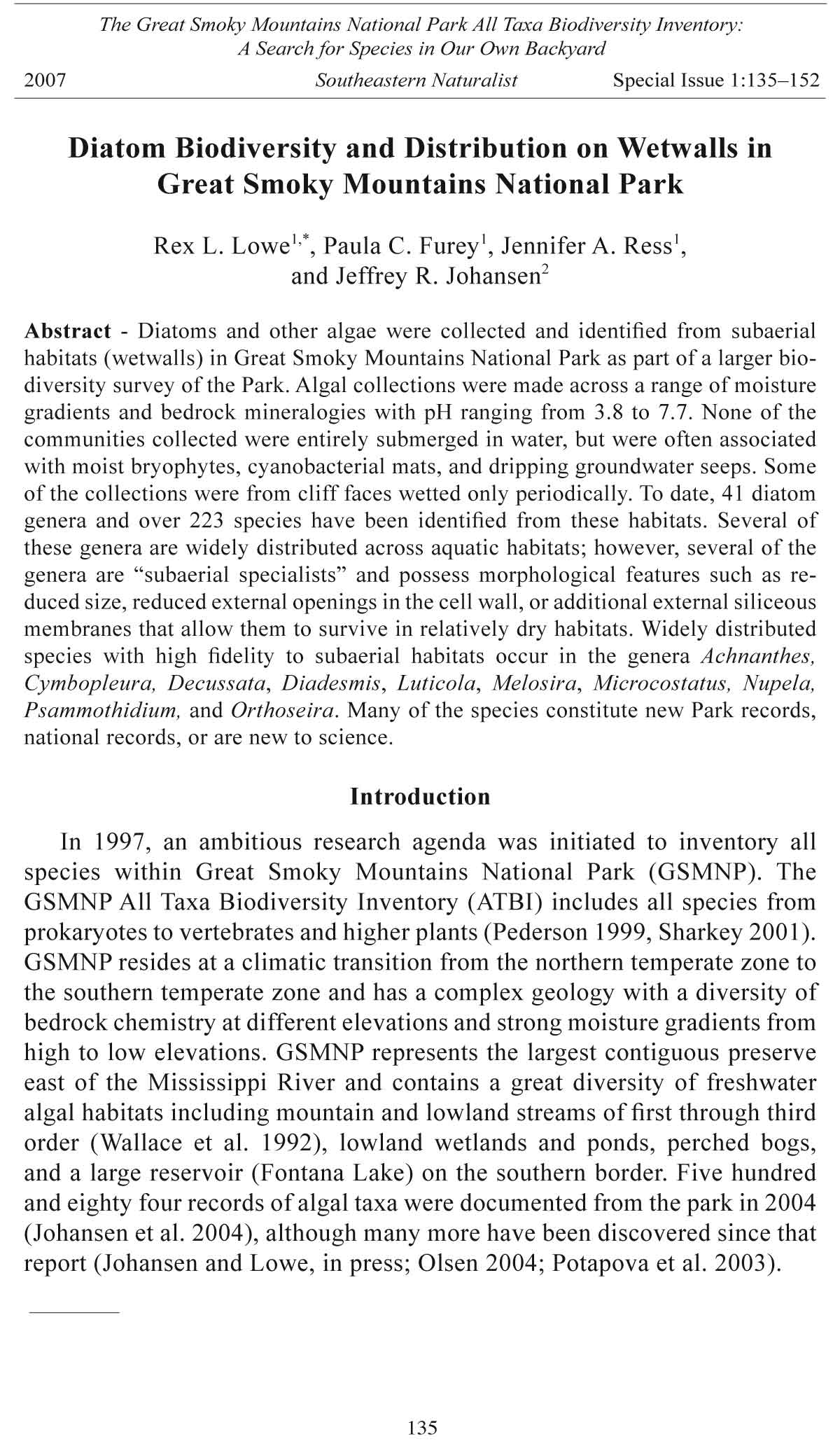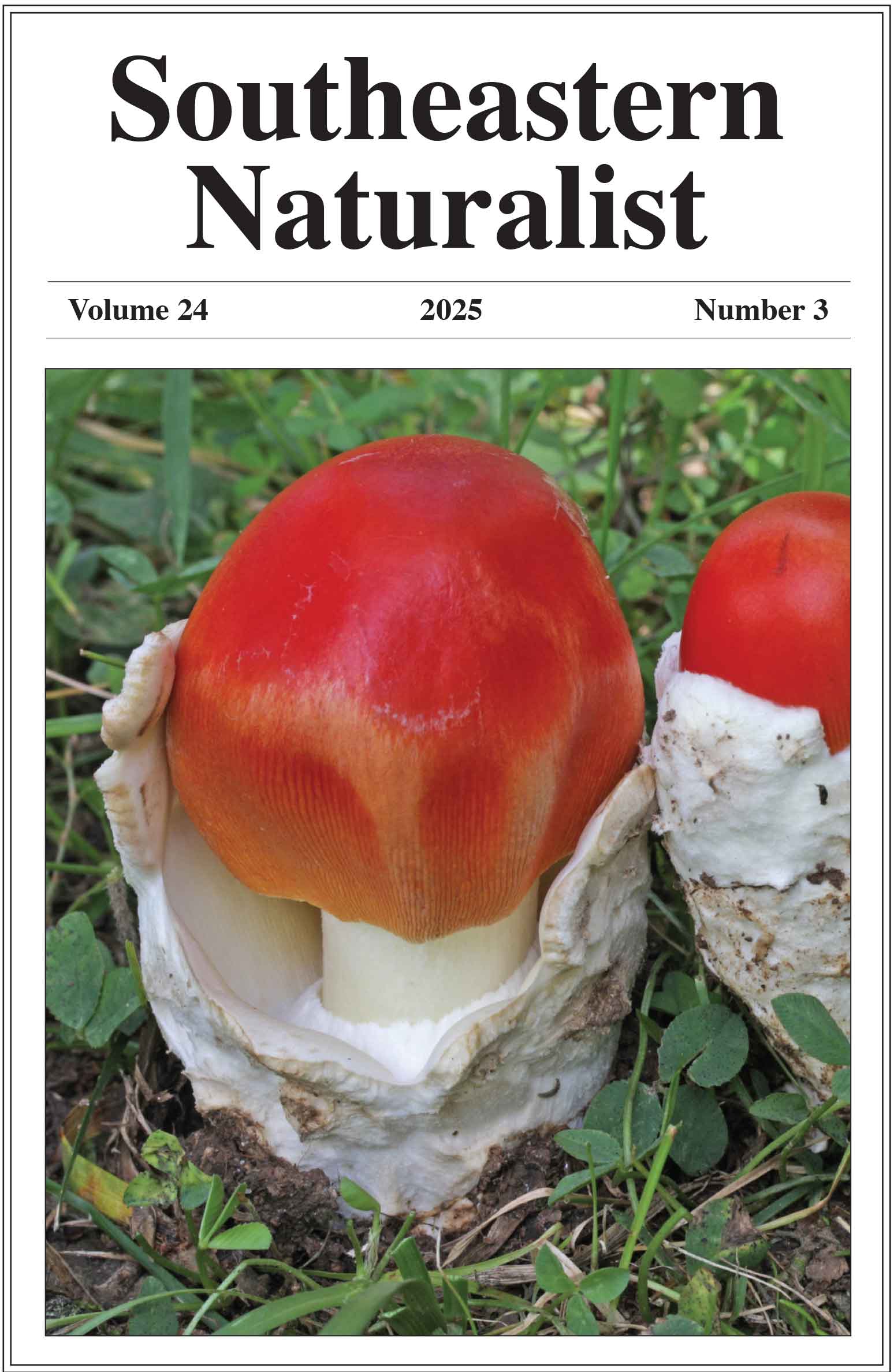Diatom Biodiversity and Distribution on Wetwalls in
Great Smoky Mountains National Park
Rex L. Lowe1,*, Paula C. Furey1, Jennifer A. Ress1,
and Jeffrey R. Johansen2
Abstract - Diatoms and other algae were collected and identified from subaerial
habitats (wetwalls) in Great Smoky Mountains National Park as part of a larger biodiversity
survey of the Park. Algal collections were made across a range of moisture
gradients and bedrock mineralogies with pH ranging from 3.8 to 7.7. None of the
communities collected were entirely submerged in water, but were often associated
with moist bryophytes, cyanobacterial mats, and dripping groundwater seeps. Some
of the collections were from cliff faces wetted only periodically. To date, 41 diatom
genera and over 223 species have been identified from these habitats. Several of
these genera are widely distributed across aquatic habitats; however, several of the
genera are “subaerial specialists” and possess morphological features such as reduced
size, reduced external openings in the cell wall, or additional external siliceous
membranes that allow them to survive in relatively dry habitats. Widely distributed
species with high fidelity to subaerial habitats occur in the genera Achnanthes,
Cymbopleura, Decussata, Diadesmis, Luticola, Melosira, Microcostatus, Nupela,
Psammothidium, and Orthoseira. Many of the species constitute new Park records,
national records, or are new to science.
Introduction
In 1997, an ambitious research agenda was initiated to inventory all
species within Great Smoky Mountains National Park (GSMNP). The
GSMNP All Taxa Biodiversity Inventory (ATBI) includes all species from
prokaryotes to vertebrates and higher plants (Pederson 1999, Sharkey 2001).
GSMNP resides at a climatic transition from the northern temperate zone to
the southern temperate zone and has a complex geology with a diversity of
bedrock chemistry at different elevations and strong moisture gradients from
high to low elevations. GSMNP represents the largest contiguous preserve
east of the Mississippi River and contains a great diversity of freshwater
algal habitats including mountain and lowland streams of first through third
order (Wallace et al. 1992), lowland wetlands and ponds, perched bogs,
and a large reservoir (Fontana Lake) on the southern border. Five hundred
and eighty four records of algal taxa were documented from the park in 2004
(Johansen et al. 2004), although many more have been discovered since that
report (Johansen and Lowe, in press; Olsen 2004; Potapova et al. 2003).
135
The Great Smoky Mountains National Park All Taxa Biodiversity Inventory:
A Search for Species in Our Own Backyard
2007 Southeastern Naturalist Special Issue 1:135–152
136 Southeastern Naturalist Special Issue 1
The focus habitats of the research reported in this manuscript are subaerial
wetwalls. Wetwalls are exposed vertical or sloping rock faces that vary
in moisture availability, but are not submerged. Moisture may be primarily
from the atmosphere (rain and fog) or from groundwater seeps. GSMNP
contains hundreds of vertical wetwalls with varying bedrock chemistry and
levels of moisture. Stream cuts, road cuts, landslides, and waterfall spray
zones in GSMNP have resulted in an abundance of wetwall habitats. We
anticipated that wetwalls would provide habitat for many species of algae
that are uncommon or absent from streams, lakes, and wetlands. Because
of periodic exposure to drying, many obligate aquatic algal taxa do not
occupy these habitats. In previous investigations (Gomez et al. 2003), we
found wetwalls to support many species of “soft” algae that are infrequently
reported. Because wetwalls are more insular than streams, with no upstream
source of algal immigrants, we expected the fl ora of wetwalls to strongly
refl ect local environmental conditions. In addition, we expected wetwalls to
be a refuge for species that might be vulnerable to competition by invasive
algal species since wetwalls are less likely to receive species introductions
from fishermen or other stream users.
The wetwall algal study by Gomez et al. (2003) was restricted to “soft”
or non-diatom algae. One hundred and eighteen algal species were reported
from the study, and 108 of these were new GSMNP records. The objective
of the present study was to investigate the diatom fl ora of GSMNP wetwalls.
We anticipated that diatom distribution on wetwalls would be correlated
with bedrock mineralogy, chemistry (including pH), wetwall elevation, and
the presence or absence of “moisture-facilitating algae," such as Nostoc,
that have the capacity to hold water in extra cellular polysaccharides or
bryophytes that provide shelter from desiccation.
Methods
Study area
GSMNP comprises over 2072 km2 (800 square miles) in the Southern
Appalachian Mountains on the border between North Carolina and Tennessee,
bridging the northern and southern temperate zones. Forested, with
elevations that range from 267 m to 2025 m rolling mountains dominate the
park. The unique northeast to southwest orientation of the mountains, large
tracts of deciduous old-growth and contiguous forests, and protection as a
national park, in addition to having remained unglaciated for over a million
years, have all contributed to a rich and abundant fauna and fl ora. For example,
the park has over 100 species of native trees and a high diversity of
lungless salamanders. The geology of GSMNP is varied, and the 25 general
categories of bedrock types are comprised of rocks with a complex depositional,
stratigraphic, metamorphic, and structural history (Southworth et al.
2005).
2007 R.L. Lowe, P.C. Furey, J.A. Ress, and J.R. Johansen 137
Wetwall sampling and analysis
The subaerial diatom fl ora was examined from wetwall samples from
collecting expeditions to the GSMNP from 2001 to 2005. In May and
August 2001, S.R. Gomez collected subaerial algal samples throughout
the park (Gomez et al. 2003). In July 2004, samples were collected by National
Park Service (NPS) personnel along with the Appalachian Highlands
Learning Center interns. Collecting expeditions to GSMNP by the Bowling
Green State University (BGSU) and John Carroll University (JCU) research
groups occurred on five separate occasions: 15–18 October 2003, 15–20
May 2004, 11–14 July 2004, 22–23 October 2004, and 15 May–11 August
2005. Sites were generally collected only once, and seasonal variability
was not assessed, although we expect it to be relatively invariable in these
subaerial communities since there is little opportunity for diatom emigration
in contrast to stream periphyton communities. Algae were collected from
drippy rock faces using forceps, pipettes, and a knife, and by squeezing
bryophytes. A total of 49 subaerial habitats from 11 different bedrock types
were sampled from elevations ranging from 363 to 1841 m (Appendix 1).
Bedrock types were selected to represent all the common types that cover the
majority of the park (from a total of 25 general bedrock units; Southworth
et al. 2005). Collection locations were geo-referenced (Garmin GPS Unit)
where global positioning system (GPS) signals were available (Coordinate
datum NAD27, UTM zone 17S). The pH of each site was measured using
EMD colorphast pH-indicator strips (range: 2.5 to 10 pH units; sensitivity of
0.2 to 0.3 pH units) in order to provide a rough estimate of differences in the
acidity of sampling locations. Samples collected by S.R. Gomez were preserved
in 2% buffered formaldehyde; the remaining samples were preserved
in a minimum of 2% glutaraldehyde.
Diatoms were cleaned in boiling nitric acid and air dried onto cover
glasses. Permanent diatom mounts for light microscope (LM) analysis were
made using Naphrax® mounting medium. Permanent diatom slides will be
made for future reference at BGSU and will also be deposited in the GSMNP
Science Center, the diatom herbaria at the California Academy of Science
(CAS), and the Academy of Natural Sciences of Philadelphia (ANSP).
Slides were analyzed with an Olympus BX51 Photomicroscope with highresolution
DIC optics. A minimum of 200 diatom frustules was counted
from each sample. Digital images were recorded with a monochromatic
camera (Spot®) attached to the microscope and a computer. Diatoms were
identified to the lowest taxonomic level possible using standard references.
References consisted of: Krammer and Lange-Bertalot (1986), Krammer
and Lange-Bertalot (1988), Krammer and Lange-Bertalot (1991a), Krammer
and Lange-Bertalot (1991b), Patrick and Reimer (1966), Johansen and Sray
(1998), Potapova et al. (2003) and Werum and Lange-Bertalot (2004). Cover
glasses, mounted on specimen stubs and sputter-coated with 10 nm gold/palladium
alloy, were analyzed on a high-resolution Hitachi S-2700 scanning
electron microscope (SEM).
138 Southeastern Naturalist Special Issue 1
Relative abundance of diatoms at each site, calculated both at the species
and genus levels, were normalized with an arcsine transformation (arcsine
of the square root; Sokal and Rohlf 1995). Ordination of sites was first
conducted based on a reduced species list using non-metric multidimensional
scaling (MDS) of Bray Curtis similarities. Diatom taxa that occurred
at a minimum of three sites were included in the MDS analysis in order
to ensure sufficient data for ordination, thus reducing the total number of
taxa from 223 to 98. A high stress value for the MDS output indicated that
additional analyses should be conducted to confirm the MDS ordination.
Therefore, the clustering of sites based on species- or genera-level similarity
for both a reduced and complete taxa list was examined using a dendrogram
of group-average linking of Bray Curtis similarities. The cluster analysis
using the complete species list is presented in this study because the overall
patterns were similar between the two methods and the use of the complete
species list provided a more inclusive picture of the wetwall communities
and information on some of the unique wetwall sites. Elevation, pH, latitude,
longitude, watershed, and microhabitat type (epiphytic [bryophyte associated]
or epilithic) were used as factors for examining clustering patterns.
Statistical tests were performed with Primer 5 version 5.2.9 (Primer–E Ltd.,
2002). Unique communities of algae were identified as those sets of sites
with either >85% relative abundance of a single taxon or <10% similarity
with other sets of sites based on the cluster analysis. Clusters were further
subdivided into ten subclusters based on a similarity cutoff of 15%. Common
wetwall taxa were selected based on species and genera that were found
at >3% overall relative abundance (calculated with all sites considered together)
or present at >20% of the sites.
Results
Site pH ranged from 3.8–5.5, with the exception of three unique sites that
had pH between 7.2–7.7. Acidic areas were generally found at the higher
elevation sites. The three sites with pH > 7 were all found in the Whiteoak
Sink area of the GSMNP.
Forty-one genera and 223 species were identified from the wetwall sites.
Nineteen wetwall genera were commonly present across all sites (Table 1).
Achnanthes, Diadesmis, Eunotia, Navicula, Nupela, and Pinnularia were
present at >50% of the sites and Chamaepinnularia, Encyonema, Frustulia,
Gomphonema, and Nitzschia at >20% of the sites (Table 1). Of these genera,
Diadesmis (15%) and Eunotia (21%) also had high overall relative abundance
across sites (Table 1). Within these genera, 23 wetwall species were considered
notable, either because they had a higher mean relative abundance or
were frequently present at sites. Nitzschia hantzschiana Rabenhorst (5.8%),
Eunotia praerupta v. bigibba (Kützing) Grunow (5.5%), Cymbopleura rupicola
(Grunow) Krammer (5.7%), and Navicula keeleyi Patrick (9.6%) had the
highest overall relative abundances (Table 1). Diadesmis contenta v. biceps
(Grunow) Hamilton, Diadesmis contenta (Grunow) D.G. Mann, Diadesmis
2007 R.L. Lowe, P.C. Furey, J.A. Ress, and J.R. Johansen 139
perpusilla (Kützing) D.G. Mann, Navicula keeleyi, Achnanthes subrostrata
v. appalachiana Camburn and Lowe, Navicula angusta Grunow, Nitzschia
hantzschiana, and Nupela neglecta Ponader, Lowe and Potapova were present
at over 35% of the sites (Table 1). Four site-groups ([A], [B], [C, D, E], and
[F, G, H, I, J, J
1
, J
2
] were identified by the 2-D MDS ordination (Fig. 1, stress
Table 1. Table of common species based on overall relative abundance (all sites considered
together) or taxa frequently present across sites. Species were selected if overall abundance
was >3% or the taxa were present at >20% of the sites.
Mean relative % of sites
Taxon abundance where present
Achnanthes subrostrata v. appalachiana 3.9 38.8
Achnanthidium exiguum 0.5 22.5
Chamaepinnularia spp. 0.5 40.8
Cymbopleura rupicola 5.7 6.1
Decussata placenta 0.7 24.5
Diadesmis contenta 1.6 46.9
Diadesmis contenta v. biceps 2.0 38.8
Diatoma mesodon 2.9 20.4
Encyonema minutum 1.4 24.6
Eunotia exigua 2.6 34.7
Eunotia nymanniana 0.4 24.5
Eunotia praerupta v. bigibba 5.5 20.4
Frustulia crassinervia 0.8 20.4
Frustulia krammeri 2.9 26.5
Gomphonema parvulum 0.5 20.4
Meridion circulare 0.7 30.6
Microcostatus krasskei 3.4 32.7
Navicula angusta 1.8 44.9
Navicula keeleyi* 9.6 59.2
Nitzschia hantzschiana 5.8 38.8
Nupela spp. 2.8 51.0
Pinularia spp. 3.9 51.9
Planothidium lanceolatum 2.6 28.6
Psammothidium marginulatum 2.3 22.5
* Navicula keeleyi to be transferred to Diadesmis in a subsequent manuscript.
Figure 1. Two-dimensional
non-metric multidimensional
scaling
(MDS) ordination for
the 49 wetwall sites
based on the Bray-Curtis
similarities on arc
sine root transformed
relative abundance data
for species present at
> 3 sites. MDS stress =
0.16. Codes (A through
J, J1, and J2) represent
grops of sites identified
in the cluster analysis for all species data (see Fig. 2). Four general site-groups were
identified: (A), (B), (C, D, E), and (F, G, H, I, J, J1, J2).
140 Southeastern Naturalist Special Issue 1
value 0.16). Due to the high stress value, these patterns were also examined
with a cluster analysis, both for the reduced taxa list and for all taxa. Similar
patterns were observed for both cluster analyses. Therefore, the dendrogram
with all taxa considered is shown since it provides the most information on
diatom community composition across sites (Fig. 2). The four site–groups
identified by the MDS ordination also clustered with less than a 10% site
similarity threshold (Fig. 2). At <15% similarity, 10 site-groups or clusters
were identified (Fig. 2). With notable exceptions, all sites clustered at <50%
similarity, which suggests that the diatom community composition was quite
variable at the different wetwall sites.
The two sites forming cluster A (CR-J1C and NDT-V1A) were strongly
dominated by Pinnularia subcapitata v. hilseana (Janisch ex Rabenhorst)
Müller, with Eunotia cf. glacialis Meister also being very abundant at
CR-J1C (Fig. 2, Table 2). The sites forming cluster B were dominated by
Table 2. Sites where community composition was comprised of one taxon ≥ 85% relative abundance.
"*" = sites identified as unique in the dendrogram.
Site code Species Relative abundance
ACT-15 Eunotia praerupta v. bigibba 95.5
CDR-J5E Eunotia cf. fallax 92.0
CR-CAT1C Nitzschia hantzshciana 97.0
CR-J1C* Pinnularia subcapitata v. hilseana 95.0
NG-J9A Tetracyclus rupestris 85.0
WS-4A Cymbopleura rupicola 99.5
WSF-6C* Cymbopleura rupicola 99.5
Figure 2. Dendrogram of the 49 seep-wall sites, using group-average clustering from
Bray Curtis similarities on arc sine root transformed relative abundances of the all
species. A <10% (dashed–dot line) and <15% (dotted line) similarity threshold are
identified. The unique sites and locations separated at a <15% (dotted line) similarity
threshold are indicated by A–J below the x–axis.
2007 R.L. Lowe, P.C. Furey, J.A. Ress, and J.R. Johansen 141
Cymbopleura rupicola, with relative abundances of 99.5% at site WS-4A
and WSF-6C, and 82% at WSF-6B (Fig 2, Table 2). Cymbopleura rupicola
was only present at these three alkaline sites. Cluster C, site LF-5A, was
comprised mainly of Frustulia crassinervia (Brébisson ex W. Smith) Lange-
Bertalot and Frustulia krammeri Lange-Bertalot and Metzeltin (Fig. 2,
Table 2). The two sites forming cluster D included RC-PF6F, which was
characterized by Eunotia exigua (Brébisson ex Kützing) Rabenhorst and
Eunotia sp.12 with relative abundances at 67.5% and 22.5%, respectively,
and LCR-7B, which was primarily composed of Psammothidium marginulatum
(Grunow) Bukhtiyarova and Round, and secondarily of Eunotia
exigua, with relative abundances of 75% and 20.5%, respectively. Psammothidium
marginulatum was found in only five other communities in low
relative abundance (Fig. 2). Cluster E included six sites that were generally
dominated by Eunotia taxa, especially Eunotia praerupta v. bigibba and
Eunotia cf. fallax A. Cleve (Fig. 2, Table 2). Cluster F, site TCT-2B, was
also dominated by Eunotia taxa (Fig. 2). The two sites in Cluster G were
dominated by different taxa, but Diatoma mesodon Kützing and Fragilariaforma
virescens (Ralfs) Williams and Round were present at both. Cluster
H, site NG-J9A, was dominated by a single taxon, Tetracyclus rupestris
(Braun) Grunow, that was absent from all other sites (Fig. 2, Table 2). The
three sites forming Cluster I (LRR-2, LRT-PF1, and CR-CAT1C), all had
Nitzschia hantzschiana as a common taxon at 16.5, 79, and 97% relative
abundances, respectively (Fig. 2, Table 2). Cluster J was the largest cluster
of sites, and overall, these sites were highly variable in their taxonomic
composition. Cluster J1 tended to be comprised of Diadesmis taxa (including
Navicula keeleyi, yet to be transferred to Diadesmis), and sites at Cluster
J2 were dominated by Microcostatus krasskei (Hustedt) Johansen and Sray
(Fig. 2). Within all the clusters (A–J), seven communities were characterized
as unique based on a relative abundance of ≥85% of one taxon (Table 2).
Within the MDS ordination, factor codes and bubble plots of pH, geology,
elevation, latitude, longitude, and watershed were examined to explore the siteclustering
patterns in response to the environmental variables and to examine
taxon-specific clustering with environmental variables (plots not shown).
However, no patterns were observed for any of the environmental variables
alone, or considered with a specific taxon (with the exception of Cymbopleura
rupestris, which was found at the three sites with the highest pH).
Discussion
Two hundred and twenty-three diatom species and varieties within 41
genera were recorded from the wetwall communities in GSMNP (see Figs.
3–35 for illustrations of some of the more common taxa ). These communities
were dominated by several taxa that are common in subaerial habitats.
Many species in the genus Diadesmis, for example, have been reported
from numerous wetwall studies (Dayner and Johansen 1991, Johansen et al.
1983a, Lowe and Collins 1973, McMillim and Rushforth 1985). Wetwall
142 Southeastern Naturalist Special Issue 1
Figures 3–22. Common taxa denoted in Table 1; “*” signifies taxa denoted in Table
2. 3) Achnanthes subrostrata v. appalachiana, raphe valve, 4) Achnanthes subrostrata
v. appalachiana, rapheless valve, 5) Achnanthidium exiguum, raphe valve, 6)
Achnanthidium exiguum (Grun.) Czarnezki, rapheless valve, 7) Diatoma mesodon,
8) Diatoma mesodon, girdle view, 9) Chamaepinnularia mediocris (Krasske) Lange-
Bertalot, 10) Diadesmis contenta, 11) Diadesmis contenta v. biceps, 12) Navicula
keeleyi, 13) Diadesmis perpusilla, 14) Gomphonema cf. parvulum Kütz., 15) Pinnularia
subcapitata v. hilseana*, 16) Decussata placenta (Ehr.) Lange-Bertalot &
Mezeltin 17) Cymbopleura rupicola*, 18) Eunotia praerupta v. bigibba*, 19) Eunotia
nymanianna Grun., 20) Eunotia cf. fallax*, 21) Eunotia exigua, 22) Encyonema
minutum (Hilse ex Rabh.) D.G. Mann.
2007 R.L. Lowe, P.C. Furey, J.A. Ress, and J.R. Johansen 143
diatoms must withstand a greater range of environmental variables than
aquatic species (Patrick 1977). Unlike truly aquatic habitats, subaerial envi-
Figures 23–35. Common taxa denoted in Table 1; “*” signifies taxa denoted in Table
2. 23) Frustulia krammeri, 24) Frustulia. crassinervia, 25) Meridion circulare
(Grev.) Ag., 26) Navicula angusta, 27) Nitzschia hantzschiana*, 28) Microcostatus
krasskei, 29) Nupela sp., 30) Planothidium lanceolatum, raphe valve, 31) Planothidium
lanceolatum (Bréb. ex Kütz.) Round & Bukhtiyarova, rapheless valve, 32) Psammothidium
marginulatum, raphe valve, 33) Psammothidium marginulatum, rapheless
valve, 34) Tetracyclus rupestris*, 35) Tetracyclus rupestris*, girdle view.
144 Southeastern Naturalist Special Issue 1
ronments are moist, but can periodically become dry for long periods. Also,
because these diatoms often live in a film of water, they do not experience
the thermal stability that aquatic taxa experience. Wetwall diatoms may also
experience more intense ultraviolet radiation than aquatic forms that are
more protected by water (Johansen 1999).
Many wetwall diatoms have a reduced number of areolae or possess
areolae that are occluded with a siliceous lamina (e.g., species of Nupela,
Diadesmis, Chamaepinnularia, and Eunotia, Figs. 36–39). These morphological
features may be adaptations to reduce water loss in periodically dry
habitats. Some common taxa without obviously reduced external openings,
such as Decussata, Luticola, Microcostatus, and Nitzschia (Figs. 40–43), are
also typical of diatom communities in subaerial habitats.
Diatom community structure on the wetwall habitats observed in this
study was diverse and highly variable. Higher pH appeared to be an important
variable separating the three Whiteoak Sink samples from the more
acidic sites throughout the park. However, we anticipated that diatom communities
from habitats with similar bedrock mineralogy and pH would
be very similar, and this pattern was not usually the case with the acidic
wetwalls. Even diatom collections from the same acidic wetwall separated
by a few centimeters were often very dissimilar. In retrospect, this is less
surprising since the microscale patchiness of algal communities in streams
is common. We expect that subtle differences in shading and moisture
probably play a large role in determining diatom community structure.
Diatom communities that are only a few cm apart can occupy very different
microhabitats as rock faces possess subtle differences in surface
morphology that influence exposure of the community to sunlight and drying.
These subtle differences can also regulate the distribution of sympatric
patches of non-diatom algae and bryophytes that are also likely to play a
role in diatom distribution. Several of the wetwalls supported macroscopic
growths of algae rich in extracellular water-retaining polysaccharides that
can provide a moist environment for diatoms during otherwise dry periods.
These kinds of habitats seemed favorable to Nitzschia hantzschiana,
for example. Macroscopic growths of Nostoc, Stigonema, Mesotaenium,
and several coccoid cyanobacteria were common but highly patchy on
the wetwalls, which might also reflect patchy environmental variables
or the history of chance colonization by propogules. We did not examine
potential top-down impacts of grazers in these communities, but noted the
presence of protozoa and occasional dipteran larvae. Grazers may be selective
in consumption of algae (Gresens and Lowe 1994).
The cluster analysis (Fig. 2) illustrates the dissimilarity among diatom
communities and again probably indicates that parameters that we did
not measure are generating these differences. However, we did identify
several notable assemblages that were <15% similar to the rest of the assemblages
sampled.
2007 R.L. Lowe, P.C. Furey, J.A. Ress, and J.R. Johansen 145
The two assemblages in cluster A were largely separated by dominant
populations of Pinnularia subcapitata v. hilseana and Eunotia cf. glacialis.
These two diatoms have been reported from subaerial and acid
habitats from both Europe and North America (Beyens 1989, Dixit et
al. 1999). Both collections in this cluster were from drippy bryophytes
similar to the report of Beyens (1989), which may indicate that this is a
preferred habitat of Pinnularia subcapitata v. hilseana. Eunotia is also
common on mosses.
The three collections from wetwalls in Whiteoak Sinks (cluster B) were
the only samples that we collected from limestone-dominated alkaline bedrock.
Cymbopleura rupicola dominated these communities and was found
nowhere else. This taxon has been reported from similar alkaline subaerial
habitats (Klemenčič 2002). Its disjunct distribution on wetwalls in the
GSMNP may indicate its strong habitat specificity.
Cluster C is represented by a single collection from a bryophyte-covered
rock of Thunderhead Sandstone in a spray zone of Laurel Falls. Waterfall
spray zones are wetted for longer periods than many of the wetwall habitats
and also have a continuous source of diatom immigrants and this may, in
part, account for its uniqueness. The assemblage was dominated by two species
of Frustulia.
Figures 36–39. Species of diatoms showing reduced external openings. 36) Nupela
sp., 37) Diadesmis perpusilla (Kütz.) D.G. Mann, 38) Eunotia sp., 39) Chamaepinnulari
soehrensis (Krasske) Lange-Bertalot (scale bar = 4 μm).
146 Southeastern Naturalist Special Issue 1
Cluster D was another small cluster of only two collections (Thunderhead
Sandstone near a waterfall at Ramsay Cascade and Metcalf Phyllite on Laurel
Creek Road). These two communities were only 23% similar to each
other but <15% similar to the remainder of the assemblages (Fig. 2). These
two assemblages were related by their relatively dense populations of Eunotia
exigua, a cosmopolitan acidophilic species (Lowe 1974).
Cluster E, with six collections, was separated from the other sites largely
by species of Eunotia. Although these six collections are less than 15% similar
to the rest of the assemblages, they are not closely related to each other
(Fig. 2).
Cluster F contained a single unique assemblage dominated by Eunotia
diodon Ehrenberg and Eunotia rhomboidea Hustedt. This was the only
collection in this analysis that came from a soil seep and may reflect peculiar
aspects of this unique environment. Surveys of diatom soil flora are
few, but an extensive study by Lund (1945) illustrates the richness of the
flora. GSMNP, with diverse soil types, should hold a large number of soil
diatom species. We hope to pursue the algal soil flora of GSMNP in succeeding
years.
Cluster G consisted of two assemblages collected from disjunct sites
(Thunderhead Sandstone seep and Logarm Quartzite dripwall). Both
collection sites had the same pH, however (5.0). The sites were relatively
Figures 40–43. Common wetwall diatom species without obviously reduced external
openings. 40) Decussata placenta, , 41) Luticola sp., 42) Microcostatus krasskei , 43)
Nitzschia hantzschiana (scale bar = 5μm).
2007 R.L. Lowe, P.C. Furey, J.A. Ress, and J.R. Johansen 147
dissimilar to each other (Fig. 2), but were distinct from the remainder of the
assemblages primarily due to large populations of Diatoma mesodon and
Fragilariaforma virescens. Although Diatoma mesodon is often found in a
large variety of habitats, Fragilariaforma virescens is typically restricted to
acidic or low alkalinity habitats (Camburn and Charles 2000).
Cluster H is defined by Tetracyclus rupestris, which occurred only in this
single collection and accounted for 85% of the diatoms in this assemblage.
This is a unique community and is significant in that Tetracyclus rupestris
is seldom reported from the North American fl ora. The collection site was
a drippy Anakeesta bedrock formation at 1500 m elevation. Anakeesta provides
an acidic environment and is often high in aluminum, although we did
not measure that element in this study.
Cluster I is composed of three assemblages, each with Nitzschia hantzschiana
as a common taxon. This diatom is one of the most common
subaerial species of the genus Nitzschia and has been reported from many
different studies of subaerial algae (Dayner and Johansen 1991; Johansen et
al. 1983a; Lund 1945). The three samples in this cluster are all from drippy
wetwalls along road cuts. All three of these samples contained conspicuous
quantities of green algae or cyanobacteria. Such algae might facilitate the
presence of Nitzschia, which is highly motile and would be capable of moving
through the algal matrix.
The remaining 28 collections all cluster together (J), but within this
large cluster, several sub–clusters can be identified driven, by assemblages
with large populations of Diadesmis species and by Microcostatus krasskei.
These taxa have strong fidelity to subaerial habitats and are generally not
seen in abundance in aquatic habitats.
In addition to the challenges of working with the vertical nature of
wetwalls, the highly variable and heterogeneous nature of the algal communities,
along with some of the variations in microhabitat discussed
above, highlights the need to consider both spatial scale and sampling
strategy when designing wetwall studies or biodiversity surveys. For example,
to minimize the effects of microhabitat variation, artificial wetwall
substrates may be helpful in elucidating the impact of microscale habitat
features on algal community structure, or several wetwall areas may need
to be sampled in order to adequately characterize the diversity of an area
or to track changes in algal assemblages over time, or in response to environmental
changes. Additionally, the range of values covered for pH
for the majority of our sites (pH 3.8–5.5) was narrow, and future studies
should include a broader range of pH, especially across the intermediate
values not examined in this study (pH 5.5–7.2). Similarly, elevation and
geology gave no apparent environmental signal in the diatom composition,
although these influences may have been masked by microscale variability
or small sample size, and future studies may require more intensive sampling,
experimental work, or finer-scale bedrock determination.
148 Southeastern Naturalist Special Issue 1
Conclusions
We described the diatom fl ora from several wetwalls throughout GSMNP.
Some of the species from this research appear to be new species and will
be described and published elsewhere. Aside from these new taxa, many of
the diatoms have been reported from other wetwall studies and have been
noted as typical subaerial species. Although we found little correlation with
bedrock mineralogy, chemistry including pH, and wetwall elevation, we
did observe highly variable and very diverse diatom community structure
among the wetwall habitats. We found unique diatom communities, along
with wetwall-specific diatom taxa that appeared to have special adaptations
to these subaerial habitats. In order to better understand these understudied
communities, future research should explore these subaerial habitat
adaptations, such as presence of additional external siliceous membranes
or interactions with soft algal communities. Additionally, further research
is needed to understand the complexities of these unique algal communities
and habitats, including examination of factors that may have a more
dominant role in shaping wetwall community structure, such as moisture
gradients and sources, infl uences of microscale variability, substrate type
and shading, or the role of ultraviolet radiation. We feel that it is particularly
important to examine these communities at an appropriate scale. Habitat
variables and community structure could vary over millimeter distances on
wetwalls, and the small and spatially unique nature of these microhabitats
should be taken into consideration in the experimental design and sampling
in future wetwall studies.
Acknowledgments
This research was supported by the National Science Foundation (DEB 0315979)
and grants from Discover Life In America. We are also very grateful for support and
facilitation from the National Park Service, Jeanie Hilton and volunteers from Discover
Life In America, and the Appalachian Highlands Learning Center interns. This
manuscript was greatly improved thanks to detailed reviews by Marina Potapova,
Peter Siver, and one anonymous reviewer.
Literature Cited
Beyens, L. 1989. Moss-dwelling diatom assemblages from Edgeøya (Svalbard).
Polar Biology 9:423–430.
Camburn, K.E., and D.F. Charles. 2000. Diatoms of Low-alkalinity Lakes in the
Northeastern United States. Academy of Natural Sciences of Philadelphia Special
Publication 18, Philadelphia, PA. 152 pp.
Dayner, D.M., and J.R. Johansen. 1991. Observations on the algal fl ora of Seneca
Caverns, Seneca County, Ohio. Ohio Journal of Science 91:118–121.
Dixit, S.S, J.P. Smol, D.F. Charles, R.M. Hughes, S.G. Paulsen, and G.B. Collins.
1999. Assessing water quality changes in the lakes of the northeastern United
States using sediment diatoms. Canadian Journal of Fisheries and Aquatic Sciences
56(1):131–152.
2007 R.L. Lowe, P.C. Furey, J.A. Ress, and J.R. Johansen 149
Gomez, S. 2002. Epilithic aerial algae of Great Smoky Mountains National Park.
M.Sc. Thesis. John Carroll University, University Heights, OH. 78 pp.
Gomez, S.R., J.R. Johansen, and R.L. Lowe. 2003. Epilithic aerial algae of Great
Smoky Mountains National Park. Biologia, Bratislava 58:603–615.
Gresens, S.E., and R.L. Lowe. 1994. Periphyton patch preference in grazing chironomid
larvae. Journal of the North American Benthological Society 13:89–99.
Johansen, J.R. 1999. Diatoms of aerial habitats. Pp 264–273, In E.F. Stoermer and
J.P. Smol (Eds.). The Diatoms: Applications for the Environmental and Earth
Sciences. Cambridge University Press, Cambridge, UK.
Johansen, J.R., and R.L. Lowe. In press. Draparnaldia appalachiana sp. Nov.
(Chaetophoraceae, Chlorophyceae) from the Great Smoky Mountains National
Park.
Johansen, J.R., and J.C. Sray. 1998. Microcostatus Gen. Nov., a new aerophilic diatom
genus based on Navicula Krasskei Hustedt. Diatom Research 13:93–101.
Johansen, J.R., R.L. Lowe, S.R. Gomez, J.P. Kociolek and S.A. Makosky. 2004.
New algal species records for the Great Smoky Mountains National Park, USA,
with an annotated checklist of all reported algal species for the park. Algological
Studies 111:17–44.
Johansen, J.R., S.R. Rushforth and J.D. Brotherson. 1983a. The algal fl ora of Navajo
National Monument, Arizona, USA. Nova Hedwigia 38:501–553.
Johansen, J.R., S.R. Rushforth, R. Orbendorfer, N. Fungladda, and J. Grimes. 1983b.
The algal fl ora of selected wet walls in Zion National Park, Utah, USA. Nova
Hedwigia 38:765–808.
Klemencic, A.K. 2002. Kopenske alge na bentonskem zidu, kamniten zidu, apnencasti
skali in deblu lipe (Tilia platyphyllos) v Sloveniji. Natura Sloveniae
4:21–30.
Krammer, K. and H. Lange-Bertalot. 1986. Bacillariophyceae. 1. Teil: Naviculaceae.
in Ettl, H., Gerloff, J., Heynig, H. and Mollenhauer, D. (Eds) Süsswasser
fl ora von Mitteleuropa, Band 2/1. Gustav Fischer Verlag: Stuttgart, New York.
876 pp.
Krammer, K. and H. Lange-Bertalot. 1988. Bacillariophyceae. 2. Teil: Bacillariaceae,
Epithemiaceae, Surirellaceae. in Ettl, H., Gerloff, J., Heynig, H. and
Mollenhauer, D. (Eds) Süsswasserfl ora von Mitteleuropa, Band 2/2. VEB Gustav
Fischer Verlag: Jena, Germany. 596 pp.
Krammer, K. and H. Lange-Bertalot. 1991a. Bacillariophyceae. 3. Teil: Centrales,
Fragilariaceae, Eunotiaceae. in Ettl, H., Gerloff, J., Heynig, H. and Mollenhauer,
D. (Eds) Süsswasserfl ora von Mitteleuropa, Band 2/3. Gustav Fischer Verlag:
Stuttgart, Jena, Germany. 576 pp.
Krammer, K. and H. Lange-Bertalot. 1991b. Bacillariophyceae. 4. Teil: Achnanthaceae,
Kritische Ergänzungen zu Navicula (Lineolatae) und Gomphonema,
Gesamtliteraturverzeichnis Teil 1-4. in Ettl, H., Gärtner, G., Gerloff, J.,
Heynig, H. and Mollenhauer, D. (Eds) Süsswasserfl ora von Mitteleuropa, Band
2/4. Gustav Fischer Verlag: Stuttgart, Jena, Germany. 437 pp.
Lowe, R.L. 1974. Environmental requirements and pollution tolerance of freshwater
diatoms. Environmental Protection Agency. Washington, DC. PA-670/4-74-007.
340 pp.
Lowe, R.L., and G.B. Collins. 1973. An aerophilous diatom community from
Hocking Co., Ohio. Transactions of the American Microscopical Society
92:492–496.
150 Southeastern Naturalist Special Issue 1
Lund, J.W.G. 1945. Observations on soil algae. I. The ecology size and taxonomy of
British soil diatoms. The New Phytologist 44:56–110.
McMillim, M., and S.R. Rushforth. 1985. The diatom fl ora of a steam vent of Kilauea
Crater, Island of Hawaii. Pacific Science 39:294–301.
Olsen, C.E. 2004. The algal fl ora of selected seeps and waterfalls in the Great Smoky
Mountains National Park. M.Sc Thesis. John Carroll University, University
Heights, OH. 106 pp.
Patrick, R. 1977. Ecology of freshwater diatoms-diatom communities. Pp. 133–191,
In D. Werner, (Ed.). The Biology of Diatoms. Blackwell Scientific Publications,
London, UK.
Patrick, R., and C.W. Reimer. 1966. The diatoms of the United States. V1. Monograph
Academy of Natural Science Philadelphia 13(1):1–688.
Potapova, M.G., K.C. Ponader, R.L. Lowe, T.A. Clason, and L.A. Bahls. 2003.
Small-celled Nupela species from USA rivers. Diatom Research 18:293–306.
Pederson, D. 1999. Scientists are trying to identify every living thing in the Smokies
National Park. Newsweek, November 22, 1999.
Sharkey, M.J. 2001. The all taxa biological inventory of the Great Smoky Mountains
National Park. Florida Entomologist 84:556–564.
Sokal, R.R., and F.J. Rohlf. 1995. Biometry. 3rd Edition. W.H. Freeman, New York,
NY. 468 pp.
Southworth, S., A. Schultz, and D. Denenny. 2005. Generalized geological map
of Bedrock Lithologies and surficial deposits in the Great Smoky Mountains
National Park Region, Tennessee and North Carolina. US Geological Survey,
Resten, VA. Open-File Report 2004-1410.
Wallace, B.J., J. Webster, and R.L. Lowe. 1992. High-gradient streams of the Appalachians.
Pp. 133–191, In C.T. Hackney, S.M. Adams, and W.A. Martin (Eds.).
Biodiversity of the Southeastern United States/Aquatic Communities. John Wiley
and Sons Inc., Hoboken, NJ, USA, pp. 133-191.
Werum, M., and H. Lange-Bertalot. 2004. Diatoms in springs and elsewhere under
the infl uence of hydrogeology and anthropogenic impacts. Iconographia Diatomologica
13:1–480.
2007 R.L. Lowe, P.C. Furey, J.A. Ress, and J.R. Johansen 151
Appendix 1. Site codes for wetwall sampling locations, including pH, latitude, longitude, elevation, a brief site description, county and state. See Southworth
et al. (2005) for a detailed description of the geology of GSMNP. Elev. = elevation (m).
Code Rock type pH Latitude, Longitude Elev. Description County
ACT-15 Anakeesta Formation 3.8 N35.64388°, W83.44135° 1585 Rock wall on side of Alum Cave Trail Sevier, TN
ACT-16 Anakeesta Formation 4.2 N35.63944°, W83.43933° 1353 Rock wall on side of Alum Cave Trail Sevier, TN
ACT-9 Anakeesta Formation 4.2 N35.65108°, W83.44094° 1841 Drippy rock outcrop on side of Alum Cave Trail Sevier, TN
AFT-5 Cades Sandstone 5.4 N35.61027°, W83.88346° 0494 Moss covered rock on side of Abrams Falls Trail Blount, TN
CDR-J5E Thunderhead Sandstone 5.0 N35.56807°, W83.48183° 1804 Drip wall on Clingmans Dome Road Swain, NC
CF-5A Roaring Fork Sandstone 4.8 N35.6894°, W83.5389° 0421 Wet rock outside of spray zone at Cataract Falls Sevier, TN
CF-5C Roaring Fork Sandstone 4.8 N35.6894°, W83.5389° 0421 Wet rock outside of spray zone at Cataract Falls Sevier, TN
CR-CAT1C Basement Complex 5.4 N35.63438°, W83.0605° 1012 Drip wall on Cataloochee Road Haywood, NC
CR-CAT3C Basement Complex 5.0 N35.63434°, W83.06041° 1012 Drip wall on Cataloochee Road Haywood, NC
CR-CAT4C Basement Complex 5.0 N35.63438°, W83.06024° 1012 Drip wall on Cataloochee Road Haywood, NC
CR-J1C Basement Complex 4.6 N35.6393°, W83.05980° 1085 Moss covered rock wall on Cataloochee Road Haywood, NC
CR-J2C Basement Complex 4.7 N35.6363°, W83.06043° 1012 Drippy rock wall on Cataloochee Road Haywood, NC
CR-J2F Basement Complex 4.7 N 35.6363°, W83.06043° 1012 Drip wall on Cataloochee Road Haywood, NC
CRT-5A Wilhite Formation 5.3 N35.61388°, W83.92841° 0363 Drippy rock wall on side of Cooper Road Trail Blount, TN
CTT-3 Anakeesta Formation 4.7 N35.62498°, W83.48005° 1445 Moss covered rock wall on Chimney Tops Trail Sevier, TN
ECT-9 Basement Complex 4.7 N35.61019°, W83.25756° 1116 Moss covered rock wall on Enloe Creek Trail Swain, NC
GMT-1A Roaring Fork Sandstone 4.7 N35.75869°, W83.23397° 0865 Rock outcrop on side of Gabes Mountain Trail Swain, NC
HRT-8A Great Smoky Group 4.7 N35.4884°, W83.8382° 0732 Drippy rock outcrop, west edge, Hungary Ridge Trail Swain, NC
HRT-8C Great Smoky Group 4.7 N35.4884°, W83.8382° 0732 Drippy rock outcrop, west edge, Hungary Ridge Trail Swain, NC
HRT-9B Great Smoky Group 4.7 N35.4955°, W83.8337° 0762 Drippy rock on Hungary Ridge Trail Swain, NC
IFF-JC4A Thunderhead Sandstone 5.0 N35.59225°, W83.63309° 0921 Seeping rock wall outside falls area, Indian Flats Fall Sevier, TN
LCR-7A Metcalf Phyllite 5.3 N35.64937°, W83.71536° 0436 Drippy rock wall, east side of tunnel, Laurel Creek Road Blount, TN
LCR-7B Metcalf Phyllite 5.3 N35.64937°, W83.71536° 0436 Drippy rock wall, east side of tunnel, Laurel Creek Road Blount, TN
LCR-7C Metcalf Phyllite 5.3 N35.64937°, W83.71536° 0436 Drippy rock wall, west side of tunnel, Laurel Creek Road Blount, TN
152 Southeastern Naturalist Special Issue 1
Code Rock type pH Latitude, Longitude Elev. Description County
LCR-7D Metcalf Phyllite 5.3 N35.64937°, W83.71536° 436 Drippy rock wall, east side of tunnel, Laurel Creek Road Blount, TN
LCT-J6A Roaring Fork Sandstone 4.4 N35.6503°, W83.1149° 1067 Rock outcrop on Little Cataloochee Trail Haywood, NC
LF-5A Thunderhead Sandstone 4.7 N35.67828°, W83.59410° 792 Moss covered rock outside spray zone, Laurel Falls Sevier, TN
LRR-1E Cades Sandstone 4.7 N35.66073°, W83.70399° 402 Shady, drippy rock wall on Little River Road Blount, TN
LRR-1I Cades Sandstone 5.4 N35.66073°, W83.70399° 402 Shady, drippy rock wall on Little River Road Blount, TN
LRR-2 Thunderhead Sandstone 4.7 N35.66428°, W83.62217° 585 Drippy rock wall on Little River Road Sevier, TN
LRT-PF1 Elkmont Sandstone 5.0 N35.64861°, W83.56193° 719 Drippy rock wall on side of Little River Trail Sevier, TN
MCT-3 Anakeesta Formation 4.7 N35.65419°, W83.65647° 643 Moss covered rock wall on side of Meigs Creek Trail Sevier, TN
MF-7E Thunderhead Sandstone 4.7 N35.66897°, W83.67510° 439 Wet rock outside of spray zone at Meigs Falls Blount, TN
MPT-JC1 Thunderhead Sandstone 5.0 N35.6134°, W83.6478° 640 Seep along Middle Prong Trail Blount, TN
NDT-V1A Anakeesta Formation 4.0 N35.48201°, W83.45709° 1122 Moss covered seep on rock, side of Noland Divide Trail Swain, NC
NG-J9A Anakeesta Formation 5.3 N35.62533°, W83.41475° 1500 Drippy rock wall on Newfound Gap Road Sevier, TN
OCT-J7B Logarm Quartzite 5.0 N35.64947°, W83.06924° 809 Drip wall on Old Cataloochee Turnpike Haywood, NC
RC-PF6F Thunderhead Sandstone 5.0 N35.67495°, W83.59257° 1305 Wet rock outside of spray zone at Ramsay Cascade Sevier, TN
RFR-1 Roaring Fork Sandstone 5.0 N35.71007°, W83.47802° 561 Drippy rock wall on Roaring Fork Loop Sevier, TN
SGT-2 Metcalf Phyllite 5.5 N35.63090°, W83.73291° 1740 Drippy rock wall on side of Schoolhouse Gap Trail Blount, TN
TCF-10B Great Smoky Group 4.7 N35.4922°, W83.8354° 732 Drippy rock outside spray zone, Twentymile Creek Falls Swain, NC
TCF-10C Great Smoky Group 4.7 N35.4922°, W83.8354° 732 Drippy rock outside spray zone, Twentymile Creek Falls Swain, NC
TCT-2B Great Smoky Group 4.7 N35.4719°, W83.8705° 488 Soil seep, side of Twentymile Creek Trail Swain, NC
TCT-5 Great Smoky Group 4.7 N35.4776°, W83.8474° 640 Moss covered rock outcrop, Twentymile Creek Trail Swain, NC
TD-2H Roaring Fork Sandstone 5.0 N35.71138°, W83.48255° 521 Drippy rock outside spray zone, Place of 1000 Drips Sevier, TN
THWF-C2 Roaring Fork Sandstone 4.0 N35.7598°, W83.2358° 853 Rock outcrop on Trail to Hen Wallow Falls Cocke, TN
WS-4A Limestone/Dolomite 7.7 N35.63658°, W83.74900° 500 Large rock outcrop in Whiteoak Sink Blount, TN
WSF-6B Cades Sandstone 7.2 N35.63886°, W83.74804° 518 Wet rock outside of spray zone at Whiteoak Sink Falls Blount, TN
WSF-6C Cades Sandstone 7.2 N35.63886°, W83.74804° 518 Wet rock outside of spray zone at Whiteoak Sink Falls Blount, TN














 The Southeastern Naturalist is a peer-reviewed journal that covers all aspects of natural history within the southeastern United States. We welcome research articles, summary review papers, and observational notes.
The Southeastern Naturalist is a peer-reviewed journal that covers all aspects of natural history within the southeastern United States. We welcome research articles, summary review papers, and observational notes.